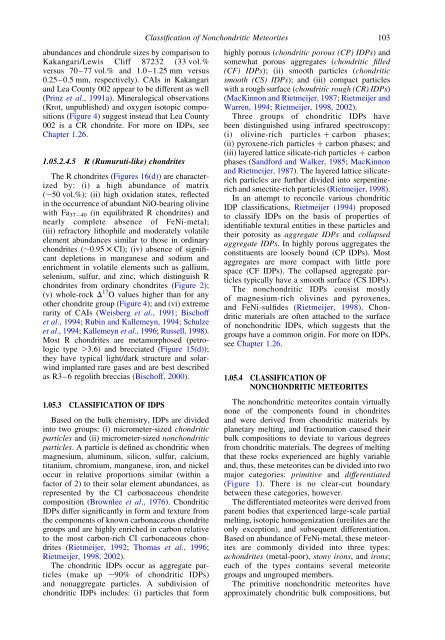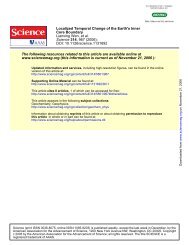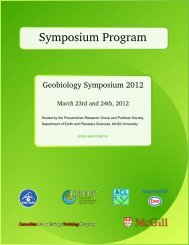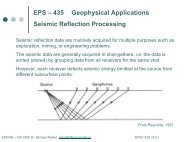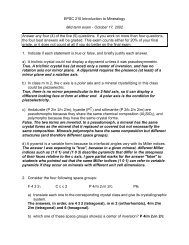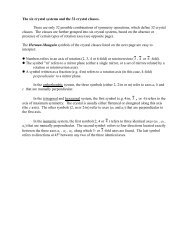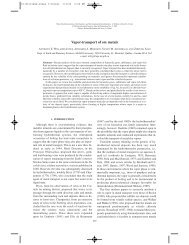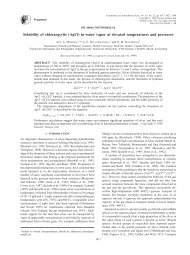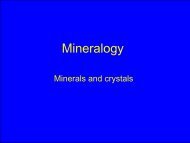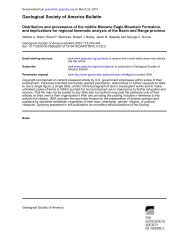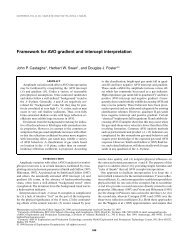05 Classification of.. - Department of Earth and Planetary Sciences
05 Classification of.. - Department of Earth and Planetary Sciences
05 Classification of.. - Department of Earth and Planetary Sciences
You also want an ePaper? Increase the reach of your titles
YUMPU automatically turns print PDFs into web optimized ePapers that Google loves.
abundances <strong>and</strong> chondrule sizes by comparison to<br />
Kakangari/Lewis Cliff 87232 (33 vol.%<br />
versus 70–77 vol.% <strong>and</strong> 1.0–1.25 mm versus<br />
0.25–0.5 mm, respectively). CAIs in Kakangari<br />
<strong>and</strong> Lea County 002 appear to be different as well<br />
(Prinz et al., 1991a). Mineralogical observations<br />
(Krot, unpublished) <strong>and</strong> oxygen isotopic compositions<br />
(Figure 4) suggest instead that Lea County<br />
002 is a CR chondrite. For more on IDPs, see<br />
Chapter 1.26.<br />
1.<strong>05</strong>.2.4.5 R (Rumuruti-like) chondrites<br />
The R chondrites (Figures 16(d)) are characterized<br />
by: (i) a high abundance <strong>of</strong> matrix<br />
(,50 vol.%); (ii) high oxidation states, reflected<br />
in the occurrence <strong>of</strong> abundant NiO-bearing olivine<br />
with Fa 37 – 40 (in equilibrated R chondrites) <strong>and</strong><br />
nearly complete absence <strong>of</strong> FeNi-metal;<br />
(iii) refractory lithophile <strong>and</strong> moderately volatile<br />
element abundances similar to those in ordinary<br />
chondrites (,0.95 £ CI); (iv) absence <strong>of</strong> significant<br />
depletions in manganese <strong>and</strong> sodium <strong>and</strong><br />
enrichment in volatile elements such as gallium,<br />
selenium, sulfur, <strong>and</strong> zinc, which distinguish R<br />
chondrites from ordinary chondrites (Figure 2);<br />
(v) whole-rock D 17 O values higher than for any<br />
other chondrite group (Figure 4); <strong>and</strong> (vi) extreme<br />
rarity <strong>of</strong> CAIs (Weisberg et al., 1991; Bisch<strong>of</strong>f<br />
et al., 1994; Rubin <strong>and</strong> Kallemeyn, 1994; Schulze<br />
et al., 1994; Kallemeyn et al., 1996; Russell, 1998).<br />
Most R chondrites are metamorphosed (petrologic<br />
type .3.6) <strong>and</strong> brecciated (Figure 15(d));<br />
they have typical light/dark structure <strong>and</strong> solarwind<br />
implanted rare gases <strong>and</strong> are best described<br />
as R3–6 regolith breccias (Bisch<strong>of</strong>f, 2000).<br />
1.<strong>05</strong>.3 CLASSIFICATION OF IDPS<br />
Based on the bulk chemistry, IDPs are divided<br />
into two groups: (i) micrometer-sized chondritic<br />
particles <strong>and</strong> (ii) micrometer-sized nonchondritic<br />
particles. A particle is defined as chondritic when<br />
magnesium, aluminum, silicon, sulfur, calcium,<br />
titanium, chromium, manganese, iron, <strong>and</strong> nickel<br />
occur in relative proportions similar (within a<br />
factor <strong>of</strong> 2) to their solar element abundances, as<br />
represented by the CI carbonaceous chondrite<br />
composition (Brownlee et al., 1976). Chondritic<br />
IDPs differ significantly in form <strong>and</strong> texture from<br />
the components <strong>of</strong> known carbonaceous chondrite<br />
groups <strong>and</strong> are highly enriched in carbon relative<br />
to the most carbon-rich CI carbonaceous chondrites<br />
(Rietmeijer, 1992; Thomas et al., 1996;<br />
Rietmeijer, 1998, 2002).<br />
The chondritic IDPs occur as aggregate particles<br />
(make up ,90% <strong>of</strong> chondritic IDPs)<br />
<strong>and</strong> nonaggregate particles. A subdivision <strong>of</strong><br />
chondritic IDPs includes: (i) particles that form<br />
<strong>Classification</strong> <strong>of</strong> Nonchondritic Meteorites 103<br />
highly porous (chondritic porous (CP) IDPs) <strong>and</strong><br />
somewhat porous aggregates (chondritic filled<br />
(CF) IDPs); (ii) smooth particles (chondritic<br />
smooth (CS) IDPs); <strong>and</strong> (iii) compact particles<br />
with a rough surface (chondritic rough (CR) IDPs)<br />
(MacKinnon <strong>and</strong> Rietmeijer, 1987; Rietmeijer <strong>and</strong><br />
Warren, 1994; Rietmeijer, 1998, 2002).<br />
Three groups <strong>of</strong> chondritic IDPs have<br />
been distinguished using infrared spectroscopy:<br />
(i) olivine-rich particles þ carbon phases;<br />
(ii) pyroxene-rich particles þ carbon phases; <strong>and</strong><br />
(iii) layered lattice silicate-rich particles þ carbon<br />
phases (S<strong>and</strong>ford <strong>and</strong> Walker, 1985; MacKinnon<br />
<strong>and</strong> Rietmeijer, 1987). The layered lattice silicaterich<br />
particles are further divided into serpentinerich<br />
<strong>and</strong> smectite-rich particles (Rietmeijer, 1998).<br />
In an attempt to reconcile various chondritic<br />
IDP classifications, Rietmeijer (1994) proposed<br />
to classify IDPs on the basis <strong>of</strong> properties <strong>of</strong><br />
identifiable textural entities in these particles <strong>and</strong><br />
their porosity as aggregate IDPs <strong>and</strong> collapsed<br />
aggregate IDPs. In highly porous aggregates the<br />
constituents are loosely bound (CP IDPs). Most<br />
aggregates are more compact with little pore<br />
space (CF IDPs). The collapsed aggregate particles<br />
typically have a smooth surface (CS IDPs).<br />
The nonchondritic IDPs consist mostly<br />
<strong>of</strong> magnesium-rich olivines <strong>and</strong> pyroxenes,<br />
<strong>and</strong> FeNi-sulfides (Rietmeijer, 1998). Chondritic<br />
materials are <strong>of</strong>ten attached to the surface<br />
<strong>of</strong> nonchondritic IDPs, which suggests that the<br />
groups have a common origin. For more on IDPs,<br />
see Chapter 1.26.<br />
1.<strong>05</strong>.4 CLASSIFICATION OF<br />
NONCHONDRITIC METEORITES<br />
The nonchondritic meteorites contain virtually<br />
none <strong>of</strong> the components found in chondrites<br />
<strong>and</strong> were derived from chondritic materials by<br />
planetary melting, <strong>and</strong> fractionation caused their<br />
bulk compositions to deviate to various degrees<br />
from chondritic materials. The degrees <strong>of</strong> melting<br />
that these rocks experienced are highly variable<br />
<strong>and</strong>, thus, these meteorites can be divided into two<br />
major categories: primitive <strong>and</strong> differentiated<br />
(Figure 1). There is no clear-cut boundary<br />
between these categories, however.<br />
The differentiated meteorites were derived from<br />
parent bodies that experienced large-scale partial<br />
melting, isotopic homogenization (ureilites are the<br />
only exception), <strong>and</strong> subsequent differentiation.<br />
Based on abundance <strong>of</strong> FeNi-metal, these meteorites<br />
are commonly divided into three types:<br />
achondrites (metal-poor), stony irons, <strong>and</strong> irons;<br />
each <strong>of</strong> the types contains several meteorite<br />
groups <strong>and</strong> ungrouped members.<br />
The primitive nonchondritic meteorites have<br />
approximately chondritic bulk compositions, but


